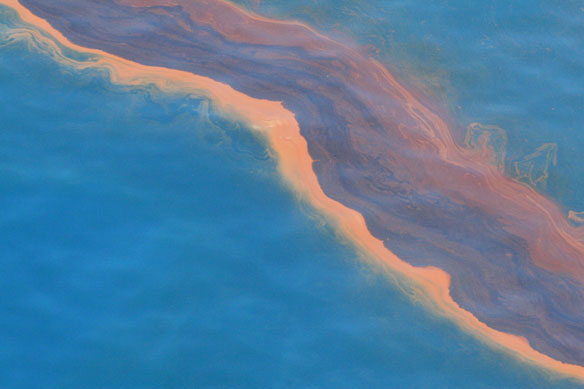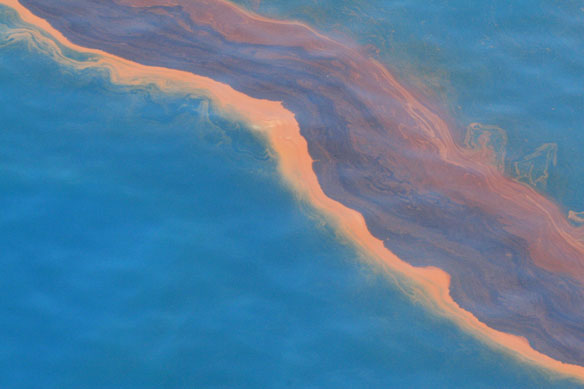
Heavy band of oil from the Deepwater Horizon, seen during an overflight on May 12, 2010. Captions and Photo source: NOAA
Excerpts;
The 2010 blowout of the Macondo well in the waters of the Gulf of Mexico resulted in the region’s largest oil spill in U.S. history. As the Deepwater Horizon (DWH) incident unfolded, in an effort to prevent the oil from coming to the surface and reaching coastal and marsh ecosystems, chemical dispersants were injected at the wellhead. These powerful dispersants, typically used to break up oil slicks at the sea surface had never been used in such large quantities and over such a prolonged period of time in the deep ocean.
A new study published in Environmental Science & Technology, led by University of Miami (UM) Rosenstiel School of Marine & Atmospheric Science Associate Professor of Applied Marine Physics Claire Paris, is the first to examine the effects of the use of unprecedented quantities of synthetic dispersants on the distribution of an oil mass in the water column, based on a modeling approach…
Read Full Article, Science Daily
First Study of Dispersants in Gulf Spill Suggests a Prolonged Deepwater Fate (01-27-2011)
To combat last year’s Deepwater Horizon oil spill, nearly 800,000 gallons of chemical dispersant were injected directly into the oil and gas flow coming out of the wellhead. Scientists begin to assess and to raise questions about what impact the deep-water residue of oil and dispersant, might have had on environment and marine life in the Gulf.
EPA: It Was Wise To Use Dispersants…, The New York Times (08-03-2010)
Many scientists expressed grave concerns about the unprecedented aerial spraying of chemical dispersants in the Gulf of Mexico region.
Scientists and Academics Call For Immediate Halt of Chemical Dispersants in Gulf, The Ocean Foundation (07-26-2010)
Over 100 scientists and academic institution, research laboratory, conservation organization leaders plus human rights defenders from as far away as Norway and Greece have issued, July 18th, a joint Scientists Consensus Statement on the Use of Chemical Dispersants in the Gulf of Mexico calling for the US Administration to immediately halt chemical aerial spraying in the Gulf region. BP has used nearly two million gallons of Corexit chemical dispersants in the Gulf of Mexico as part of the cleanup effort with support from the U.S. Environmental Protection Agency (EPA). The massive volume of dispersants and the way they have been applied, both on the surface and one mile below the surface, is unprecedented. Once oil is dispersed in deep water, it cannot be recovered. The scientists believe the worst impacts of the disaster are yet to come, and without deliberate, independent scientific tracking and assessment, they could remain hidden…









